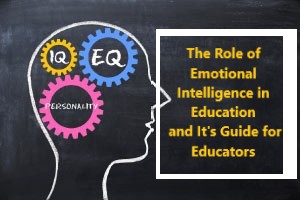In the realm of education, academic achievements often take center stage, but an equally vital aspect is often overlooked — emotional intelligence. This blog post delves into the crucial role of emotional intelligence in education, providing educators with a comprehensive guide on its significance, strategies for implementation, and the profound impact it can have on students’ academic and personal development.

Understanding Emotional Intelligence in Education
1. Defining Emotional Intelligence (EI)
- Emotional intelligence refers to the ability to recognize, understand, manage, and effectively use one’s emotions and navigate interpersonal relationships.
2. The Four Components of Emotional Intelligence
- Self-Awareness: Recognizing and understanding one’s own emotions.
- Self-Management: Effectively managing and regulating one’s emotions.
- Social Awareness: Understanding and empathizing with the emotions of others.
- Relationship Management: Nurturing positive relationships and effective communication.
The Importance of Fostering Emotional Intelligence in Students
1. Enhanced Academic Performance
- Students with high emotional intelligence often exhibit better focus, resilience, and adaptability, leading to improved academic performance.
2. Positive Classroom Environment
- Fostering emotional intelligence creates a positive and supportive classroom environment, contributing to a sense of belonging and motivation among students.
3. Conflict Resolution and Communication Skills
- Students with strong emotional intelligence are better equipped to navigate conflicts, communicate effectively, and collaborate with peers, setting the foundation for success in the workplace.
4. Emotional Regulation and Stress Management
- Emotional intelligence equips students with the tools to manage stress, handle pressure, and regulate emotions, essential skills for both academic and life success.
Strategies for Teaching Emotional Intelligence
1. Incorporate Social-Emotional Learning (SEL) Programs
- Integrate SEL programs into the curriculum, focusing on activities and lessons that promote self-awareness, self-regulation, empathy, and interpersonal skills.
2. Promote a Culture of Open Communication
- Create an environment where students feel comfortable expressing their emotions and thoughts. Encourage open dialogues, active listening, and mutual respect.
3. Teach Mindfulness and Emotional Regulation Techniques
- Introduce mindfulness practices and emotional regulation techniques, such as deep breathing exercises and guided meditation, to help students manage stress and improve focus.
4. Incorporate Emotional Intelligence in Subject Areas
- Integrate emotional intelligence discussions and activities into various subjects, connecting academic content to real-life scenarios that require emotional understanding and management.
5. Use Literature and Storytelling
- Utilize literature and storytelling to explore characters’ emotions and dilemmas. Discussing these stories can provide students with insights into different emotional perspectives and foster empathy.
6. Peer Collaboration and Group Activities
- Encourage collaborative learning experiences and group activities that require effective communication and teamwork. This fosters the development of relationship management skills.
7. Model Emotional Intelligence
- As educators, modeling emotional intelligence is paramount. Demonstrate self-awareness, regulation, and empathy in your interactions with students, creating a positive and supportive role model.
The Long-Term Benefits of Emotional Intelligence in Schools
1. Improved Mental Health and Well-being
- Students with strong emotional intelligence are more resilient in the face of challenges, leading to improved mental health and overall well-being.
2. Positive Behavior and Classroom Management
- A focus on emotional intelligence contributes to positive behavior in the classroom, reducing disciplinary issues and enhancing the overall learning experience.
3. Preparation for Success in the Workplace
- Emotional intelligence is a key predictor of success in the professional world. Students with well-developed emotional intelligence are better equipped to navigate complex work environments and collaborate effectively with colleagues.
4. Building Empathetic and Responsible Citizens
- Fostering emotional intelligence contributes to the development of empathetic and socially responsible individuals who are mindful of their impact on others and society as a whole.
Overcoming Challenges in Implementing Emotional Intelligence Education
1. Limited Time and Resources
- Incorporating emotional intelligence education may face challenges due to time constraints and limited resources. Prioritize its importance and explore creative ways to integrate it into existing curriculum structures.
2. Resistance from Traditional Educational Models
- Traditional educational models may resist changes that prioritize emotional intelligence. Advocate for its benefits, share success stories, and gradually introduce components that align with existing educational goals.
3. Training for Educators
- Educators need training to effectively incorporate emotional intelligence education into their teaching practices. Professional development programs can provide the necessary tools and knowledge.
Conclusion
The role of emotional intelligence in education is indispensable. By recognizing its significance, educators can actively contribute to the holistic development of students, preparing them not only for academic success but also for the complex challenges of life beyond the classroom. Fostering emotional intelligence creates positive learning environments, nurtures essential life skills, and sets the foundation for empathetic, resilient, and successful individuals.
Meta Description (Revised): Explore the profound impact of emotional intelligence in education with this comprehensive guide for educators. Discover the importance of cultivating emotional intelligence in students, effective teaching strategies, and the long-term benefits it brings to the learning environment.